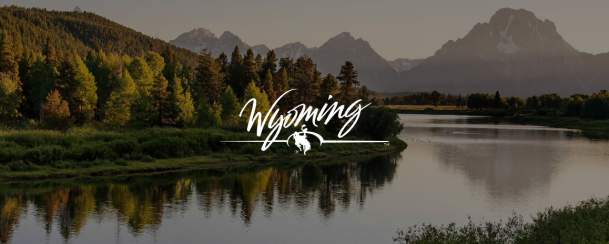More than 400 bird species make their home in Wyoming, including the trumpeter swan, the calliope hummingbird and the song sparrow. The variety of the state’s feathery occupants makes Wyoming an ideal birding destination because of the diversity of the landscapes they inhabit, from the alpine and aspen forests of Grand Teton National Park to the shimmering dunes of the Red Desert.
So grab your binoculars and a pair of comfortable walking shoes, and prepare to spot some of our flighty friends.
Yellowstone National Park
With more than 2,200,000 acres to explore, birding spots in Yellowstone are innumerable. More than 280 bird species have been documented in Yellowstone since 1872. 150 of those species are still known to nest in the national park.
Yellowstone Lake is a great place to see osprey, bald eagles and trumpeter swans. While lucky spectators can catch mountain bluebirds and black-billed magpies at Mammoth Hot Springs. Songbirds, who sing to establish and defend their territories, can be heard all over the park.
- Some Birds to Look For:
- Canada goose
- trumpeter swan
- American white pelican
- American dipper
- Clark’s nutcracker
- gray jay
- common raven
- great blue heron
- red-tailed hawk
- sandhill crane
- osprey, bald eagle
- ruffed grouse
- hairy woodpecker
- mountain bluebird
- Lincoln’s sparrow
- song sparrow
- Lazuli bunting
- black-billed magpie.
Find more birds in Yellowstone.
The Red Desert
Located between Rock Springs and Rawlins, Wyoming’s Red Desert is a rare combination of vibrant badlands, shifting sand dunes and sprawling canyons. More than 350 species of wildlife and plant species have learned to thrive in the desert.
While sand dunes may seem inhospitable, they actually help store moisture from snowmelt. For example, the dune's temporary ponds provide habitats for swans, ducks and plovers. Other not-to-miss sights in the area include jagged Boar’s Tusk and Killpecker Sand Dunes. The Killpecker Sand Dunes are home to the world's largest elk herd and wild horses making this undoubtedly a once-in-a-lifetime visit.
- Some Birds to Look For:
- sagebrush sparrow
- golden eagle
- mountain plover
- greater sage grouse
- burrowing owl
- white-faced ibis
- ferruginous hawk
- Brewer's sparrow
- sage thrasher
Hutton National Wildlife Refuge
Located on the southern Laramie Plains and framed by the mountains of southeast Wyoming, the refuge includes 1,968 acres of grassland uplands and marshlands and five natural lakes, specifically making it an ideal Wyoming birding spot. Waterfowl populate the area during spring migrations, while raptors use the refuge year-round.
- Some Birds to Look For:
- swainson’s hawk
- golden eagle
- black-crowned night heron
- pied-billed grebe
- northern harrier
- eared grebe
- black-necked stilts
Seedskadee National Wildlife Refuge
The 27,230-acre Seedskadee National Wildlife Refuge, located along the Green River in the state’s southwest region, protects a tapestry of riparian, wetland and upland-shrub habitats for more than 222 species of birds, mammals, amphibians, reptiles and fish. Greater sage grouse mate and nest near the refuge. They can be seen from late spring to late fall, which also has a flourishing trumpeter swan population.
Accordingly, the Green River and its surrounding landscape support many migratory bird species seeking insects and green foliage, including night hawks, waterfowl, shorebirds, hummingbirds and a variety of songbirds.
- Some Birds to Look For: T
- trumpeter swan
- golden eagle
- sage grouse
- Canada goose
- bald eagle
- northern harrier
- great horned owl
- cinnamon teal
- mountain bluebird
- rock wren
- horned lark
- northern flicker
Find more birds in Seedskadee National Wildlife Refuge.
Grand Teton National Park
Sixty species of mammals and more than 300 bird species reside in the national park and the Jackson Hole area in northwest Wyoming. Birds use the area’s wide range of habitats, such as alpine meadows, sagebrush flats and mountain streams to meet their water, food and shelter needs.
Hot birding spots in Grand Teton National Park include Grand View Point, Taggart Lake Trails, Cascade Canyon, Willow Flats, Christian Pond, Oxbow Bend, Antelope Flats, Menor’s Ferry at Moose and Blacktail Ponds Overlook.
- Some Birds to Look For:
- trumpeter swans
- song sparrow
- white-crowned sparrow
- sandhill crane
- cinnamon teal
- green-wing teal
- calliope humming bird
- red-naped sapsucker
- mountain bluebird
- bald eagle
- western meadowlark
Note: Many of Wyoming’s avian species are migratory birds, therefore they only spend a few months out of the year in the state and often endure long journeys to and from their wintering grounds. Help maintain their health and safety by admiring them from distance (at least 25 feet away) and respecting their nesting grounds.
Find more birds in Grand Teton.
Want to find more birding destinations in Wyoming?
The Audubon Society is an excellent resource with several active chapters in Wyoming, including the Bighorn Audubon Society in Sheridan, Murie Audubon Society in Casper, Meadowlark Audubon in Cody and Cheyenne High Plains Audubon in Cheyenne.

